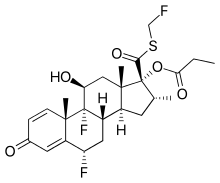Fluticasone propionate
 | |
| Clinical data | |
|---|---|
| Trade names | Flixotide (inhalatory), Flixonase and Flonase (nasal) |
| AHFS/Drugs.com | Monograph |
| License data | |
| Pregnancy category |
|
| Routes of administration | Intranasal, Inhaled, Topical Cream or Ointment |
| ATC code | |
| Legal status | |
| Legal status |
|
| Pharmacokinetic data | |
| Bioavailability | 0.51% (Intranasal) |
| Protein binding | 91% |
| Metabolism |
Intranasal Hepatic (CYP3A4-mediated) |
| Elimination half-life | 10 hours |
| Excretion | Renal |
| Identifiers | |
| |
| CAS Number | |
| PubChem CID | |
| IUPHAR/BPS | |
| DrugBank | |
| ChemSpider | |
| UNII | |
| ChEBI | |
| ChEMBL | |
| ECHA InfoCard |
100.129.097 |
| Chemical and physical data | |
| Formula | C25H31F3O5S |
| Molar mass | 500.57 g/mol |
| 3D model (JSmol) | |
| |
| |
| (verify) | |
Fluticasone propionate belongs to a class of drugs known as corticosteroids, specifically glucocorticoids, which are hormones that predominantly affect the metabolism of carbohydrates and, to a lesser extent, fat and protein. It is used to treat asthma, allergic rhinitis, nasal polyps, various skin disorders and Crohn's disease and ulcerative colitis. It is also used to treat eosinophilic esophagitis.
Medical uses
Fluticasone is used by powder or aerosol inhalation for the prophylaxis of asthma, the nasal spray is used for prophylaxis and treatment of allergic rhinitis, nasal drops are used in the treatment of nasal polyps, and creams and ointments are applied topically in the treatment of various skin disorders. It can be given orally in the treatment of Crohn’s disease and ulcerative colitis. Some benefit was also reported in coeliac disease.
Adverse effects
If taken correctly, the nasal spray and oral inhaler formulation have fewer corticosteroid side effects than the tablet formulation because they limit systemic (blood) absorption.[1] However, the systemic absorption is not negligible even with correct administration.[1] Using the spray or inhaler at higher than recommended doses or with other corticosteroids can increase the risk for serious, systemic corticosteroid induced side effects.[1][2] These side effects include weakened immune system, increased risk of systemic infections, osteoporosis, and elevated pressure in the eyes.[3]
Nasal spray
Common side effects may include nasal irritation (burning, stinging, bleeding), headache, upset stomach (nausea, vomiting), and diarrhea. Rare side effects include infection (evidenced by, e.g., fever, sore throat, and cough), vision problems, severe swelling, hoarse voice, and difficulty breathing or swallowing.[4]
Oral inhaler
Common side effects may include upper respiratory tract infection, throat irritation, thrush, cough, and headache. Rare side effects include bruising, swelling of the face/neck, depression, tiredness, and shortness of breath.[5]
Pharmacology
Fluticasone propionate is a highly selective agonist at the glucocorticoid receptor with negligible activity at androgen, estrogen, or mineralocorticoid receptors, thereby producing anti-inflammatory and vasoconstriction effects. It has been shown to have a wide range of inhibitory effects on multiple cell types (e.g. mast cell, eosinophil, neutrophil, macrophages, and lymphocytes) and mediators (e.g. histamine, eicosanoids, leukotrienes, and cytokines) involved in inflammation. Fluticasone propionate is stated to exert a topical effect on the lungs without significant systemic effects at usual doses, due to its low systemic bioavailability.
Interactions
Fluticasone propionate is broken down by CYP3A4 (Cytochrome P450 3A4), and has been shown to interact with strong CYP3A4 inhibitors such as ritonavir and ketoconazole.[1][2]
Ritonavir is a common drug used in the treatment of HIV. Coadministration of ritonavir and fluticasone may lead to increased levels of fluticasone in the body, which may lead to Cushing’s Syndrome and adrenal insufficiency.[6]
Ketoconazole, an antifungal drug, has also been shown to increase fluticasone concentration leading to systemic corticosteroid side effects.[1][2]
See also
References
- 1 2 3 4 5 Flonase[package insert]. Research Triangle Park, NC: GlaxoSmithKline; 2003.
- 1 2 3 Flovent[package insert]. Research Triangle Park, NC: GlaxoSmithKline; 2014
- ↑ "Prednisone and other corticosteroids: Balance the risks and benefits". Retrieved 4 March 2018.
- ↑ AHFS Consumer Medication Information [Internet]. Bethesda (MD): American Society of Health-System Pharmacists, Inc.; ©2008. Fluticasone Nasal Spray; [revised 2010 Sept 1; reviewed 2010 Sept 1; cited 2014 Nov 2]; [about 1 p.]. Available from: https://www.nlm.nih.gov/medlineplus/druginfo/meds/a695002.html
- ↑ AHFS Consumer Medication Information [Internet]. Bethesda (MD): American Society of Health-System Pharmacists, Inc.; ©2008. Fluticasone Oral Inhalation; [revised 2010 Sept 1; reviewed 2010 Sept 1; cited 2014 Nov 2]; [about 1 p.]. Available from: https://www.nlm.nih.gov/medlineplus/druginfo/meds/a601056.html
- ↑ Foisy, M., Yakiwchuk, E., Chiu, I. and Singh, A. (2008), Adrenal suppression and Cushing's syndrome secondary to an interaction between ritonavir and fluticasone: a review of the literature. HIV Medicine, 9: 389–396. doi: 10.1111/j.1468-1293.2008.00579.x